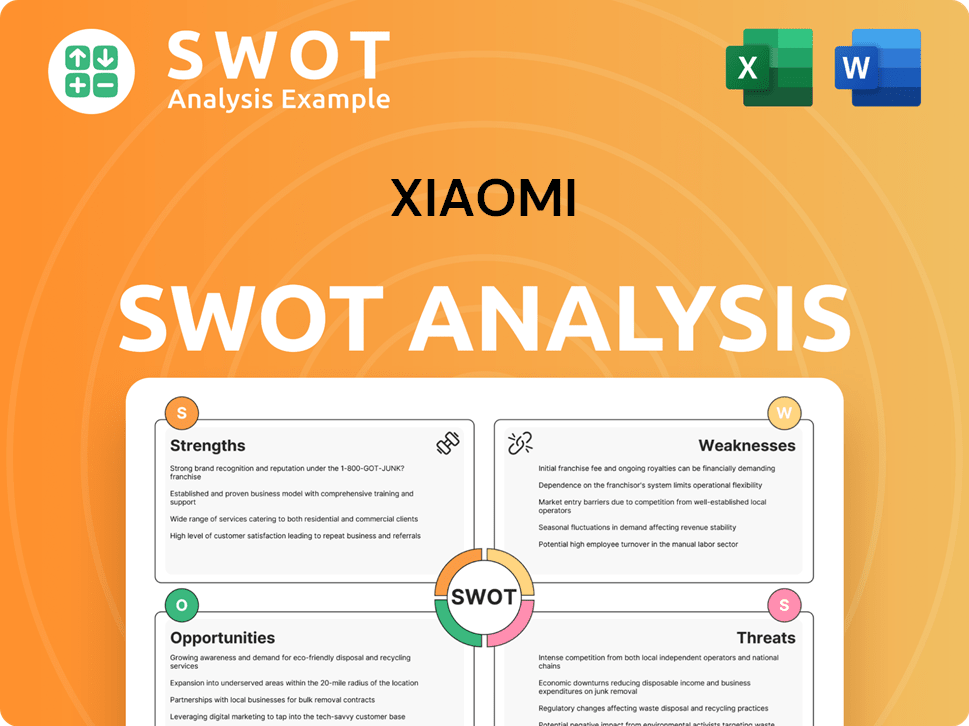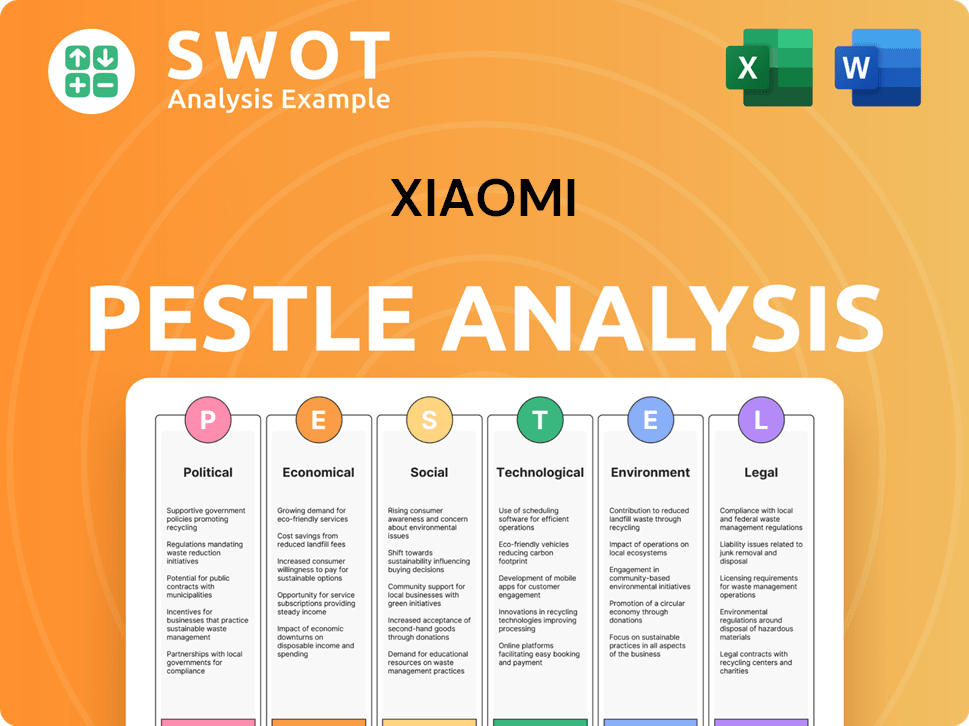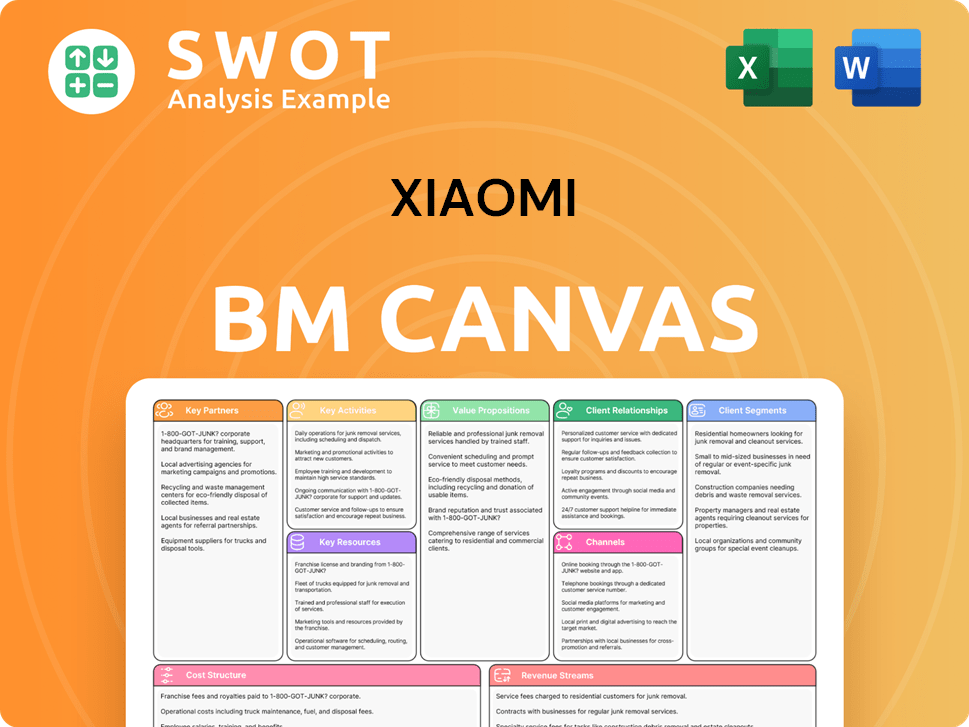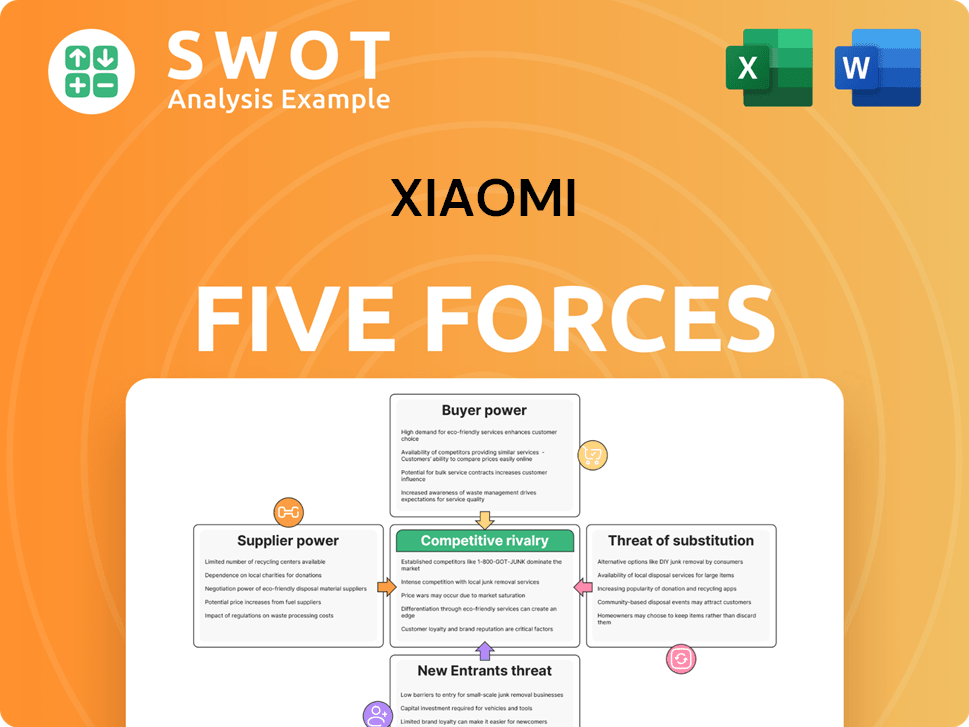Xiaomi Bundle
How Did Xiaomi Conquer the Tech World?
Founded in 2010, Xiaomi disrupted the tech industry with its mission to make cutting-edge technology accessible to everyone. From its origins in Beijing, China, Xiaomi's innovative approach, including a direct-to-consumer (DTC) model and aggressive pricing, fueled rapid growth, especially in emerging markets. But how does Xiaomi stay ahead in today's cutthroat market, and what are the secrets behind its impressive sales figures?

This deep dive explores Xiaomi's dynamic Xiaomi SWOT Analysis, revealing its evolving sales channels, ingenious marketing tactics, and strategic brand positioning. We'll dissect its Xiaomi sales strategy and Xiaomi marketing strategy, including how it leverages Xiaomi product promotion and social media. Analyzing the Xiaomi business model helps uncover the strategies behind its remarkable success, including its Xiaomi market analysis and its impact on the competitive landscape.
How Does Xiaomi Reach Its Customers?
The company's sales strategy is a blend of online and offline channels, designed to reach a global audience effectively. Initially, the company heavily relied on a direct-to-consumer (DTC) model, using its e-commerce platforms and flash sales to drive sales. This approach, combined with partnerships with major e-commerce platforms, has been crucial for its distribution and market reach.
In 2024, the company's omnichannel cumulative gross merchandise value (GMV) during the Double 11 shopping festival reached over RMB 31.9 billion, a record high. This strong performance highlights the success of its sales strategy. The company's approach has evolved to include a significant offline presence to complement its online sales.
The company's business model has expanded to include a 'new retail' approach, with a growing number of physical stores. This strategic shift aims to create a seamless customer experience across all touchpoints, including the introduction of new product categories like electric vehicles. This evolution reflects a strategic shift from a purely online model to a balanced expansion.
The company's online sales strategy focuses on direct-to-consumer sales through its e-commerce platforms and partnerships with major e-commerce sites. Flash sales and exclusive online promotions are used to create urgency and drive sales. This approach allows the company to control the customer experience and gather valuable data.
The offline retail strategy involves expanding physical stores, including Xiaomi Home stores and franchised outlets. As of June 30, 2024, the company had over 12,000 offline stores in mainland China. The company plans to increase this number to approximately 20,000 stores by 2025, integrating image display, product experience consultation, and sales functions.
Distribution channels include the company's e-commerce platforms, partnerships with e-commerce giants like Flipkart and Amazon, and a growing network of physical stores. The company's approach to distribution is a key element of its marketing strategy, ensuring products are accessible to a wide audience. This multi-channel strategy supports its global expansion goals.
The company focuses on providing a seamless customer experience across all touchpoints, both online and offline. The physical stores, often referred to as 'Millet Home,' integrate image display, product experience consultation, and sales functions. This omnichannel integration is crucial, especially as the company enters new product categories like electric vehicles.
The company's robust sales channels are a key component of its overall marketing strategy. This approach allows the company to reach a broad customer base and maintain a competitive edge. For more insights, consider reading a Brief History of Xiaomi. The company's strategic expansion into offline retail, coupled with its strong online presence, positions it well for continued growth in the competitive market.
The company's sales channels are a blend of online and offline strategies, designed to reach a global audience effectively. The company's marketing strategy includes a strong online presence, complemented by an expanding physical retail footprint.
- The company's omnichannel cumulative GMV surpassed RMB 31.9 billion during the Double 11 shopping festival in 2024.
- As of June 30, 2024, the company had over 12,000 offline stores in mainland China.
- The company plans to increase the number of offline stores in mainland China to approximately 20,000 by 2025.
- The company opened 200 smart EV sales centers across 58 cities in mainland China as of December 31, 2024.
Xiaomi SWOT Analysis
- Complete SWOT Breakdown
- Fully Customizable
- Editable in Excel & Word
- Professional Formatting
- Investor-Ready Format

What Marketing Tactics Does Xiaomi Use?
The marketing tactics of the company revolve around a cost-effective, community-driven, and digitally-focused approach. This strategy has been essential for building brand loyalty and fostering organic growth. A key element of their approach is strong community engagement, involving 'Mi Fans' in product development and marketing through platforms like the Mi Community.
The company leverages social media and digital marketing extensively, creating interactive content that resonates with younger demographics. Creative campaigns and influencer partnerships amplify reach and credibility. Content marketing initiatives showcase product capabilities and engage the community, often using user-generated content.
The company's marketing mix includes data-driven marketing, customer segmentation, and personalization, supported by significant R&D investment. This allows for targeted advertising, with a portion of YouTube advertising campaigns dedicated to brand awareness. The company emphasizes its 'honest pricing' philosophy, offering high-quality products at competitive prices, which resonates with price-sensitive consumers.
The company actively involves its 'Mi Fans' in product development and marketing. Platforms like the Mi Community provide feedback and facilitate community activities. This community-centric model boosts brand advocacy and enhances brand visibility.
The company extensively uses social media and digital marketing to create engaging content. Interactive campaigns, such as #MiIndia and #GuessTheCup, are used to promote products. Influencer partnerships are also utilized to expand reach and credibility.
Content marketing initiatives focus on showcasing product capabilities and engaging the community. User-generated content and testimonials are frequently used. The #MyHouseParty campaign, an online music festival, aimed to capture Gen-Z's attention.
The company employs data-driven marketing, customer segmentation, and personalization. Investment in R&D, which increased by 25.9% year-over-year to RMB 24.1 billion in 2024, supports these efforts. Targeted advertising is a key component of this strategy.
The company emphasizes 'honest pricing,' offering high-quality products at competitive prices. This strategy involves direct sales to consumers, bypassing traditional retail markups. This approach resonates with price-sensitive consumers.
The marketing mix has evolved to include data-driven strategies and personalization. Investment in R&D supports these advanced marketing techniques. The goal is to enhance customer engagement and sales performance.
The company's approach to Xiaomi marketing strategy is a blend of digital innovation, community engagement, and competitive pricing. This strategy has allowed the company to build a strong brand presence. This is further detailed in an analysis of the Target Market of Xiaomi. These strategies collectively contribute to the company's overall Xiaomi business model and Xiaomi sales strategy, driving growth and market share in a competitive environment. The use of data-driven marketing and targeted campaigns, supported by significant R&D investments, allows for effective Xiaomi product promotion and strong Xiaomi brand positioning. This approach has been particularly successful in markets like India, where the company has implemented various Xiaomi sales strategy in India initiatives. The company's focus on digital channels, including social media, is a key component of its Xiaomi marketing strategy for smartphones. The company's success can be attributed to its effective use of social media for marketing, as well as its competitive pricing strategy. The company's Xiaomi's pricing strategy for competitive advantage has been pivotal in attracting price-sensitive consumers. The company's distribution channels and customer acquisition strategies are also critical to its success. A thorough Xiaomi market analysis reveals the company's ability to adapt to changing consumer preferences and market dynamics, making it a strong player in the global market. The company's Xiaomi's content marketing strategy and Xiaomi's brand building strategy have been instrumental in creating a loyal customer base. The company's global marketing strategy and sales performance analysis further highlight its ability to compete effectively in various regions.
The company employs a variety of marketing tactics to engage consumers and drive sales. These tactics are designed to build brand loyalty and increase market share.
- Community-driven marketing through Mi Community.
- Extensive use of social media and digital marketing.
- Content marketing initiatives showcasing product capabilities.
- Data-driven marketing with targeted advertising.
- Competitive pricing strategy focusing on value.
- Influencer partnerships for broader reach.
Xiaomi PESTLE Analysis
- Covers All 6 PESTLE Categories
- No Research Needed – Save Hours of Work
- Built by Experts, Trusted by Consultants
- Instant Download, Ready to Use
- 100% Editable, Fully Customizable

How Is Xiaomi Positioned in the Market?
The brand positioning of the company is centered around 'Innovation for Everyone,' a strategy that emphasizes high-quality, innovative technology at accessible prices. This approach differentiates the company by democratizing technology, making it appealing to a wide audience, from tech enthusiasts to budget-conscious consumers. The core value proposition lies in offering feature-rich devices that often compete with more expensive brands, but without the premium price tag. This strategy is a key element of the company's overall Growth Strategy of Xiaomi.
This 'honest pricing' philosophy, which includes a commitment to a net profit margin of no more than 5% on its hardware business, further reinforces the value-for-money image. The company’s focus on user experience and community engagement also plays a vital role in its brand positioning. By actively listening to and engaging with its 'Mi Fans,' the company fosters a strong sense of community and loyalty.
This user-centric approach has helped build a strong brand image globally, recognized for innovation, quality, and user experience. The brand's consistency is maintained across its diverse product portfolio, which includes smartphones, AIoT devices, smart home appliances, and now electric vehicles, all integrated within its 'Human × Car × Home' smart ecosystem. This ecosystem approach enhances the overall user experience and strengthens brand appeal.
The company's brand identity is built on 'Innovation for Everyone,' offering high-quality technology at accessible prices. This value proposition focuses on feature-rich devices that compete with premium brands without the premium price. This strategy is a key element of the company's overall Xiaomi sales strategy.
The company actively engages with its 'Mi Fans,' fostering a strong community and loyalty. This approach enhances brand image and strengthens user relationships. This is a critical component of the Xiaomi marketing strategy.
The company integrates its products within a 'Human × Car × Home' smart ecosystem. This integration enhances user experience and strengthens brand appeal. This is a core element of the Xiaomi business model.
In 2024, the company's brand value reached USD 8 billion, marking a 10% annual growth. It ranked 87th in Interbrand's '2024 Global Best Brands Ranking,' demonstrating increasing global influence. This growth reflects successful Xiaomi brand positioning.
The company positions itself as a provider of innovative technology accessible to all. This involves offering high-quality products at competitive prices, making technology more inclusive. This is a key aspect of their Xiaomi product promotion.
The company prioritizes user experience and community engagement. By listening to and interacting with 'Mi Fans,' the company builds loyalty and a strong brand image. This strategy is part of their Xiaomi market analysis.
The company integrates its diverse product portfolio into a unified ecosystem. This enhances the user experience and strengthens brand appeal, creating a seamless technological environment. This approach is crucial for Xiaomi's competitive landscape analysis.
The launch of the SU7 electric vehicle enhances the company's premium brand image. This attracts new users and reshapes the user base, demonstrating adaptability to market changes. This is a key element of Xiaomi's global marketing strategy.
The company's brand value reached USD 8 billion in 2024, growing by 10% annually. This demonstrates increasing global influence and strong brand recognition. This growth is a result of effective Xiaomi's brand building strategy.
The company maintains consistent messaging across its diverse product lines. This reinforces brand identity and ensures a cohesive user experience across all products and services. This consistency is vital for Xiaomi's content marketing strategy.
Xiaomi Business Model Canvas
- Complete 9-Block Business Model Canvas
- Effortlessly Communicate Your Business Strategy
- Investor-Ready BMC Format
- 100% Editable and Customizable
- Clear and Structured Layout

What Are Xiaomi’s Most Notable Campaigns?
Xiaomi’s marketing campaigns are designed to generate excitement, build a community, and highlight the value of its products. A key element of Xiaomi's initial growth was its online flash sales model. This approach, particularly evident with the launch of the Mi 3 smartphone in India, created significant buzz and quickly sold out products, establishing a strong market presence and demonstrating high demand. These flash sales fostered a sense of urgency and exclusivity, which significantly boosted its direct-to-consumer sales model.
In Q1 2024, a large portion of Xiaomi's YouTube advertising strategy focused on brand awareness, with 40% of its campaigns dedicated to this goal. These advertisements emphasized key values such as innovation, excitement, and creativity, showcasing the transformative capabilities of Xiaomi's products, especially the advanced camera technology developed through its partnership with Leica. Campaigns for products like the Xiaomi 14 Series and Redmi Note 13 Pro Plus 5G highlighted seamless ecosystem integration and lifestyle integration.
Xiaomi also utilizes creative social media campaigns to engage with its audience. For instance, the #MiIndia campaign on Twitter encouraged users to register interest in the Mi 3 smartphone for a chance to win a power bank, and the #GuessTheCup campaign on Facebook promoted Mi Bands through a contest. These campaigns are designed to be interactive and playful, resonating with younger demographics and fostering a dedicated fan base. Collaborations with influencers and partners also play a crucial role in their strategy, as seen with the Google partnership for the Mi A1 Android One smartphone.
Xiaomi's early success was significantly driven by its flash sales model, creating a sense of urgency and exclusivity. This strategy helped build a strong market presence and demonstrated high demand, particularly with the launch of the Mi 3 smartphone.
In Q1 2024, Xiaomi allocated 40% of its YouTube advertising budget to brand awareness campaigns. These campaigns highlighted innovation and showcased the capabilities of its products, including advanced camera technology.
Xiaomi leverages social media for interactive campaigns, such as the #MiIndia and #GuessTheCup campaigns. These efforts aim to engage younger demographics and build a dedicated fan base through contests and interactive content.
Collaborations with partners like Google for the Mi A1 Android One smartphone are a key part of Xiaomi's strategy. These partnerships combine different strengths to create popular products and expand market reach. To learn more about this, explore the Growth Strategy of Xiaomi.
Xiaomi Porter's Five Forces Analysis
- Covers All 5 Competitive Forces in Detail
- Structured for Consultants, Students, and Founders
- 100% Editable in Microsoft Word & Excel
- Instant Digital Download – Use Immediately
- Compatible with Mac & PC – Fully Unlocked

Related Blogs
- What are Mission Vision & Core Values of Xiaomi Company?
- What is Competitive Landscape of Xiaomi Company?
- What is Growth Strategy and Future Prospects of Xiaomi Company?
- How Does Xiaomi Company Work?
- What is Brief History of Xiaomi Company?
- Who Owns Xiaomi Company?
- What is Customer Demographics and Target Market of Xiaomi Company?
Disclaimer
All information, articles, and product details provided on this website are for general informational and educational purposes only. We do not claim any ownership over, nor do we intend to infringe upon, any trademarks, copyrights, logos, brand names, or other intellectual property mentioned or depicted on this site. Such intellectual property remains the property of its respective owners, and any references here are made solely for identification or informational purposes, without implying any affiliation, endorsement, or partnership.
We make no representations or warranties, express or implied, regarding the accuracy, completeness, or suitability of any content or products presented. Nothing on this website should be construed as legal, tax, investment, financial, medical, or other professional advice. In addition, no part of this site—including articles or product references—constitutes a solicitation, recommendation, endorsement, advertisement, or offer to buy or sell any securities, franchises, or other financial instruments, particularly in jurisdictions where such activity would be unlawful.
All content is of a general nature and may not address the specific circumstances of any individual or entity. It is not a substitute for professional advice or services. Any actions you take based on the information provided here are strictly at your own risk. You accept full responsibility for any decisions or outcomes arising from your use of this website and agree to release us from any liability in connection with your use of, or reliance upon, the content or products found herein.